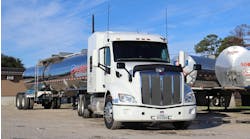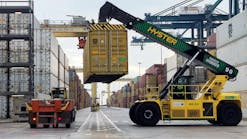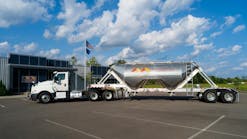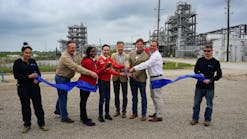The driver was medevacked to a nearby hospital. The ISO tank frame was twisted, and the product inside was leaking. A major interstate artery was shut down for more than 12 hours—far longer than anticipated.
But when all was said and done, it was another “good” day for Bryan Markland.
That’s because no one involved in the June accident was seriously injured or killed—the truck driver had a gash over his eye but otherwise came out alright considering the severity of the crash—the product was contained and recovered, the environment remediated, and first responders did everything right.
“I call it a success,” said Markland, the emergency response and security manager at Lucite International. “You don’t injure anybody, and yes it took longer than anybody wanted it to—and some of that’s getting the right resources from the right place—but in my world that’s a success, and even the state, which signed off on the project the day after the cleanup, was very happy nobody else got injured.”
Markland walked attendees through his company’s emergency response protocols in “Sideways on the Highway” at the Intermodal Tank Container Association’s 2019 Intermodal Bulk Liquid Symposium, highlighting best practices, common concerns and the importance of the PEAR model.
The scene
This particular accident occurred on Interstate 40 in Tennessee, about 30 minutes southwest of Nashville.
The carrier was hauling an ISO tank filled with 6,200 gallons of Lucite’s Methyl Methacrylate monomer, UN1247, when a car trying to change lanes in front of the tractor-trailer instead clipped its right front quarter panel, causing the passenger vehicle to spin counterclockwise into the truck’s lane.
The truck driver, believing he would end up going over the top of the car, tried to move left to lessen the impact’s potentially fatal severity, but his front tire dropped off the road, he lost control, and the truck and trailer flipped over onto the grassy median, twisting the chassis of both vehicles.
The first personnel from the five responding fire departments and the Cheatham County Emergency Management Agency arrived within approximately 15 minutes of the incident, which occurred around 9 am, and immediately went to work assessing the situation, and checking for injuries, leaks, etc.
They also contacted CHEMTREC and dialed up Markland.
“The emergency responders on the scene did everything by the book,” Markland said. “They did everything right.”
The situation
The driver of the car came away virtually unscathed, Markland said. And fortunately, the truck driver, whose truck was mangled and upside down, wasn’t trapped, so he was quickly taken by helicopter to Vanderbilt University Medical Center, where doctors closed the gash and removed glass from his face.
The overturned ISO tank immediately started leaking product, but it was a slow leak through a vent, and the product was escaping due to the pressure of the head and the tank’s position. Markland estimates they lost 20 to 30 gallons over the course of the event, which is a relatively light discharge.
“I’ve had a few rollover incidents with these containers and they’re pretty tough,” Markland attested. “They really are, at least compared with your standard tank trucks.”
Still, in an abundance of caution, residents within a half-mile were evacuated.
Meanwhile, local news already was descending on the scene, with a helicopter circling overhead before Markland arrived. The report by Nashville’s NewsChannel5’s is available at youtube.com/watch?v=kXlG6frde9U.
The response
Markland goes into every spill with the same four priorities as laid out in the PEAR model—first take care of the people (first responders, the public and the driver), then the environment (stop/contain the spill, clean up/remediate), and finally the assets (recover vehicle, container and product).
The ‘R’ is for the company’s reputation. “You’re going to take care of the first three,” Markland said. “Your reputation takes care of itself.” In this instance, the fire chief on scene had the same priorities.
He also had the Pipeline and Hazardous Materials Safety Administration’s emergency response guidebook, so he knew a little about the product on the ground—and it’s potential for polymerization. “What do you think he focused on?” Markland said. “The ‘P.’ In our world, the P means it may polymerize when involved with any kind of heat, a fire, things like that, and he was … very focused on that.”
The chief was thorough. He already had HAZMAT teams on the scene and was doing everything to contain the leaking product, including laying out foam, and setting up earthen dikes and booms. “They did a really good job laying out the area,” Markland said. But the chief’s concern for his responders, and their potential to be caught in a chemical explosion, was foremost on his mind.
So Markland’s job was to talk him down.
The conversation
First, he told the chief, yes, the product is flammable and moderately toxic but unlikely to polymerize. “I said, ‘Is there a fire or some sort of heat?’” Markland said. “He said, ‘No, but it’s just a matter of time, right?’ That’s his thought, because it’s got the ‘P’ by it so he’s focused on that. So I tell him it doesn’t work like that, there’s a chemical inhibitor added to it, and even if it warmed up to ambient temperature, we’re OK.”
But the chief wasn’t convinced. Then he caught Markland’s attention by telling him the product, which was loaded into an insulated container at 8-10 degrees C (46-50°F) currently is at 30 degrees C (86°F), to which Markland, after a long pause the chief didn’t find comforting, replied “that’s not normal.”
“That’s probably not the best thing I could have told him,” Markland admitted. “And of course his next question was ‘What is normal?’ So I finally figured out, since the tank was on its side, and I didn’t know which side the temperature gauge was on, that the gauge was in the vapor space. But that took a 30-minute-long conversation while he was over there looking at it (and Markland had him peel back the insulation and put his hand on the tank, which was cold, giving him a better indication of the product’s state).”
The aftermath
With the people protected and the product contained, responders turned their attention to remediation and asset recovery, which dragged on late into the evening and early morning partly because initial calls for rotator cranes went to a local company that was tied up at another location. Had they looked for rotators elsewhere, perhaps in Memphis, they might have cleared the scene faster.
Markland said the carrier paid for the cleanup up front, knowing if they were found at fault and weren’t proactive, the consequences would be more severe. Had they not opened the checkbook, Markland said Lucite would have stepped up, since it was their product on the ground. State troopers ticketed the driver of the car, but he’s not sure where the case went in litigation.
“It’s more timely and better if the transportation company at least directs the assets early on because they have the contracts,” he said.
Situations like this one are rare, Markland said. He estimates his team responds to 50 to 60 incidents per year, but most are relatively minor, with punctured drums representing roughly half the incidents, and the others consisting primarily of small leaks due to gasket issues and loose fittings.
“When an accident like this happens, or a leak or anything, we go back to the company, usually the transport company, and we say ‘Hey, let’s talk about this, let’s understand what happened,’” Markland said. “‘Is there an equipment issue, is it a training issue, where does it fall to?’ and … I try to keep following up on them until we get an adequate enough answer and I’m confident that they’ve taken the actions they need to take, to make sure the risk of it happening again is reduced.”
It’s hard to fault this truck driver for trying to spare the car’s driver, Markland said. But in situations where there are questions about a potential carrier, he and his logistics team follow up with site visits, putting eyes on storage terminals, the transport company’s equipment and heating locations.
“We hope we’re touching enough of the touchpoints up and down the chain where we’ve minimized the risk as much as we can, and if we find a particular carrier is having a higher percentage (of incidents), and it can’t be written off by something out of the driver’s control, we’ll have a discussion with them,” Markland said.
“It doesn’t mean you give them the boot. We’ll have some ongoing discussions about training, procedures, the standards they hold and the training requirements they have for drivers.”










